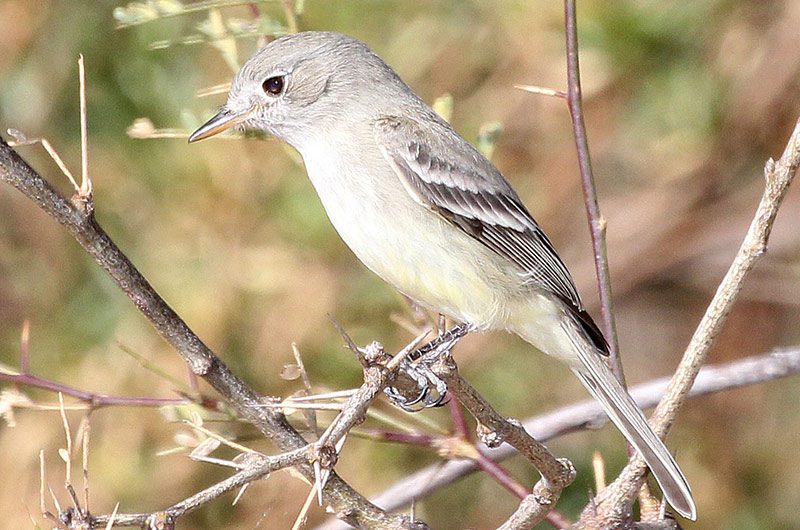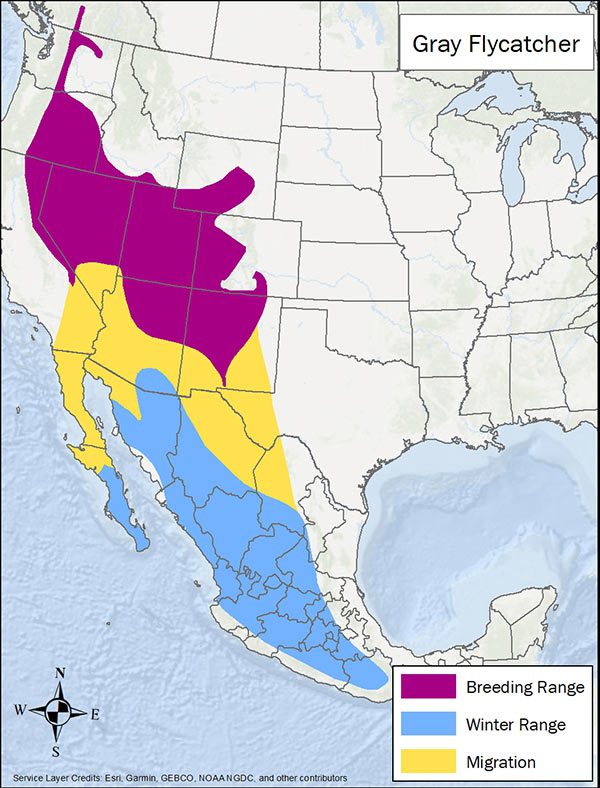LandPKS Learning
Habitat Hub

Gray Flycatcher
Until the early 1900s, gray flycatchers were believed to breed only in northern Mexico and then wander north in the U.S. in the fall. After discovering new information about gray flycatchers, such as their distinct downward tail wag, ecologists were better able to distinguish the species in the field from other similar-looking flycatchers and document its breeding range.
Empidonax wrightii
Identification
Gray flycatchers are drab, mostly gray birds with a thin, pale eye-ring and 5.5-6 in/14-15.5 cm in length. They are gray on top and whitish below with darker wings and two light-colored wing bars. They also have a long, thin bill. Males and females look similar.
Observation Tips
Gray flycatchers can be seen feeding on insects in sagebrush shrubs or trees, especially juniper and pinyon pine, either in the vegetation or on the ground. They are best distinguished from other flycatchers by their downward tail wag as they sit on a branch. In the breeding season, look for gray flycatchers in pinyon-juniper woodlands, sagebrush shrublands, or pine forests in the Great Basin and Intermountain regions. In the winter, gray flycatchers move to western Mexico in open habitat with scattered trees and shrubs.
Interesting Fact
Until the early 1900s, gray flycatchers were believed to breed only in northern Mexico and then wander north in the U.S. in the fall. After discovering new information about gray flycatchers, such as their distinct downward tail wag, ecologists were better able to distinguish the species in the field from other similar-looking flycatchers and document its breeding range.
Ideal Habitat
Gray flycatchers are most commonly found in arid woodlands and shrublands in and around the Great Basin, including the woodland-shrubland ecotone. They breed in open woodlands with a variety of evergreen trees, including junipers (Utah, one-seed, and western), pine (pinyon, ponderosa, Jeffrey, and yellow), and firs (white and Douglas). Canopy cover of trees should be >5%. Gray flycatchers also breed in sagebrush shrublands and commonly in tall, old-growth big sagebrush areas, typically found along valleys and washes. They usually place nests in pine or evergreen trees within 10 ft/3.3 yd of the ground, and also occasionally in shrubs. Winter habitat in Arizona includes mesquite bosques and streamside groves, while winter habitat in Mexico also includes subtropical thorn forest and scrub.

Range map provided by BirdLife International
Management Activities that Benefit Species – Best Management Practices (BMPs)
Maintain pinyon-juniper woodlands and mature sagebrush shrublands. To promote habitat for gray flycatchers, retain large, mature, and old-growth pinyon-juniper trees and big sagebrush shrubs. Create small openings within pinyon-juniper woodlands. Retain snags and partially dead trees for birds to perch on. Control invasive grasses, such as cheatgrass. Discourage brown-headed cowbird populations by using rotational grazing which keeps livestock dispersed or moving. Periodic rest of grazing units for at least a year also allows local gray flycatcher populations to develop without cowbird pressure.
Management Activities to Avoid
Avoid removing all shrubs and trees from an area, as this removes nesting cover and foraging opportunities. Avoid insecticide use and limit insecticide use to periods outside the breeding season. If chaining in pinyon-juniper woodlands to remove trees, limit clearing widths to 219 yd/200 m, use a light chain, and don’t chain during the winter. Avoid using prescribed fire in areas inhabited by gray flycatchers
Other Species that Benefit from Similar Habitat Management
Other species that may benefit from habitat management for gray flycatchers include pinyon jay, gray vireo, and Virginia’s warbler.
Download
Download the gray flycatcher factsheet
Other Resources
BirdLife International and Handbook of the Birds of the World. 2019. Bird species distribution maps of the world. Version 2019.1. American Grey Flycatcher
The Cornell Lab of Ornithology, Birds of the World Gray Flycatcher
The Cornell Lab of Ornithology. All About Birds Gray Flycatcher
Gillihan, SW. 2006. Partners in Flight Western Working Group. Sharing the land with pinyon-juniper birds. Salt Lake City, UT. 43 pp.
Photo credit: Alan Schmierer/Flickr
Mobile App | Data Portal | Knowledge Hub | Habitat Hub | Learning Collections | Blog | About | Contact | Support



